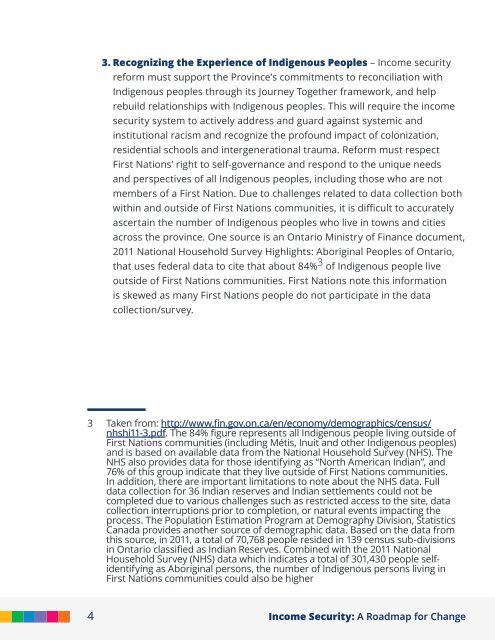Income Security: A Roadmap for Change
You also want an ePaper? Increase the reach of your titles
YUMPU automatically turns print PDFs into web optimized ePapers that Google loves.
3. Recognizing the Experience of Indigenous Peoples – <strong>Income</strong> security<br />
re<strong>for</strong>m must support the Province’s commitments to reconciliation with<br />
Indigenous peoples through its Journey Together framework, and help<br />
rebuild relationships with Indigenous peoples This will require the income<br />
security system to actively address and guard against systemic and<br />
institutional racism and recognize the profound impact of colonization,<br />
residential schools and intergenerational trauma Re<strong>for</strong>m must respect<br />
First Nations’ right to self-governance and respond to the unique needs<br />
and perspectives of all Indigenous peoples, including those who are not<br />
members of a First Nation Due to challenges related to data collection both<br />
within and outside of First Nations communities, it is diffcult to accurately<br />
ascertain the number of Indigenous peoples who live in towns and cities<br />
across the province One source is an Ontario Ministry of Finance document,<br />
2011 National Household Survey Highlights: Aboriginal Peoples of Ontario,<br />
that uses federal data to cite that about 84% 3 of Indigenous people live<br />
outside of First Nations communities First Nations note this in<strong>for</strong>mation<br />
is skewed as many First Nations people do not participate in the data<br />
collection/survey<br />
3<br />
Taken from: http://www.fin.gov.on.ca/en/economy/demographics/census/<br />
nhshi11-3pdf. The 84% figure represents all Indigenous people living outside of<br />
First Nations communities (including Métis, Inuit and other Indigenous peoples)<br />
and is based on available data from the National Household Survey (NHS) The<br />
NHS also provides data <strong>for</strong> those identifying as “North American Indian”, and<br />
76% of this group indicate that they live outside of First Nations communities<br />
In addition, there are important limitations to note about the NHS data Full<br />
data collection <strong>for</strong> 36 Indian reserves and Indian settlements could not be<br />
completed due to various challenges such as restricted access to the site, data<br />
collection interruptions prior to completion, or natural events impacting the<br />
process The Population Estimation Program at Demography Division, Statistics<br />
Canada provides another source of demographic data Based on the data from<br />
this source, in 2011, a total of 70,768 people resided in 139 census sub-divisions<br />
in Ontario classified as Indian Reserves. Combined with the 2011 National<br />
Household Survey (NHS) data which indicates a total of 301,430 people selfidentifying<br />
as Aboriginal persons, the number of Indigenous persons living in<br />
First Nations communities could also be higher<br />
4 <strong>Income</strong> <strong>Security</strong>: A <strong>Roadmap</strong> <strong>for</strong> <strong>Change</strong>
















